Gargoyle on Notre Dame, Paris
Monday, December 17, 2007
Tuesday, October 30, 2007
Back To Italy


Ernest first went to Europe as a volunteer ambulance driver for the Red Cross during World War I. (The top photo shows him in 1918.) He passed through Paris and other parts of France on his way to Italy and was impressed with the city. He was sent to the Italian front to evacuate soldiers wounded in fighting with Austrian troops. He was stationed in a town called Fossalta, not far from Mestre and Venice. His area of operation was along the Piave River, an area that was seeing heavy fighting. He was wounded by a mortar shell (over 200 pieces of shrapnel were removed from his body) and was sent to a hospital near Milan to recover. He promptly fell in love with his nurse, Agnes von Kurowsky. It was a brief affair, but one that Hemingway would talk about and embellish considerably. He also added quite a bit of drama and heroism to his war service experiences.
After the war, Ernest returned home, leaving from Genoa, with a brief trip to Naples for his first trip to Southern Italy. He arrived home to a hero's welcome and began to court Hadley Richardson.
After he and Hadley had married they moved to Paris so he could try his hand at writing. He was doing some travelling for The Star as its foreign correspondent and getting to see more of Europe. In 1922, he decided to take Hadley to Italy for a month's vacation to show her the places of his adventures.
First they went to Milan and to Biffi's cafe in the Galleria, a great indoor shopping mall and one of the places Ernest frequented with his nurse, Agnes. They travelled to Mestre, then Schio, Fossalta, and the Piave River, but he was disappointed that everything had changed. He had wanted to impress Hadley with scenes of ruin and destruction and privation, but the damage had all been cleaned up in the years after the war.
His second novel, "A Farewell to Arms", is based on his adventures in the war and his affair with his nurse during his recuperation in Milan.
Labels:
Ernest Hemingway,
Farewell to Arms,
Fossalta,
Galleria,
Milan,
Piave,
Red Cross,
Venice,
World War I
Friday, September 28, 2007
Fishing In Spain
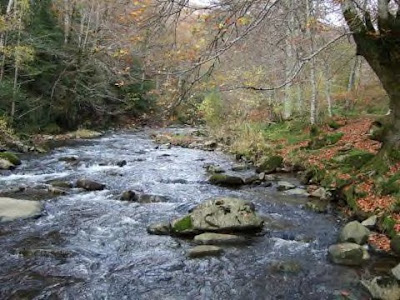

Hemingway loved to fish, and on his fourth trip to Pamplona he did some trout fishing in the Irati River in the Pyrenes.
After the Festival of San Fermin he and Hadley, Robert McAlmon, and the Smiths went into the mountains in Basque country around Burquete to relax a bit after the bullfights. Hemingway fished with worms as bait while the party had wine and cheese as they tried their luck.
This little day trip is a famous scene in "The Sun Also Rises."
Labels:
Basque,
Burquete,
Chink Dorman-Smith,
fishing,
Irati River,
Pamplona,
Pyrenes,
Robert McAlmon
Saturday, September 15, 2007
Monday, August 20, 2007
First Major Publisher

Hemingway's earliest publications were a small pamphlet "Three Stories and Ten Poems" and a small book issued in Paris by Three Mountain Press in 1924, "In Our Time". The latter was the book that Edmund Wilson read and admired and that F. Scott Fitzgerald liked so much that he recommended its author to his own publisher, Charles Scribners and Sons.
Only 1335 copies were printed.
The stories had an absolutely new style, a terse, staccato style that became his trademark.
Interestingly, all of the title words on the jacket are in lower case print.
Wednesday, July 25, 2007
Ernest In Pamplona, 1927

This is Hemingway with a bull in the Summer of 1927. The photo was taken outside of Pamplona, Spain, a town that was recommended to Hemingway by Gertrude Stein. It is in Northern Spain, just South of the French border. The famous "running of the bulls" is held here every year during the Festival of San Fermin.
Pamplona and Hemingway's vacations there were the setting and inspiration for his first novel, "The Sun Also Rises."
Another view
Labels:
bullfight,
Ernest Hemingway,
Pamplona,
San Fermin,
Sun Also Rises
Saturday, July 21, 2007
Hemingway's Birthday

Well it's not a Paris shot, but I thought something should be added for his birthday.
Ernest Miller Hemingway; born in Oak Park, Illinois, July 21, 1899.
Labels:
birthday,
Ernest Miller Hemingway,
Illinois,
Oak Park
Thursday, July 05, 2007
They Drank A Lot
Cafe De Paris
Paris had many appeals for the expats of the 1920s. It had a liberal atmosphere for artists and attracted painters, poets, and writers from all over the world. It was cheap to live there, it was an exciting, beautiful city and there was no prohibition on alcohol. In the US, Prohibition (1920-1933) was in full swing and people would go to extremes to get a drink - including moving to another country - if you could afford it.
This fact is believed to have been responsible for many of the Americans in the "lost generation" to decide to come to Paris.
In A Moveable Feast, cafe society was the important meeting ground for Hemingway and his artist friends to meet their contemporaries, discuss their work, and drink until their money ran out.
Labels:
1920's,
alcohol,
Ernest Hemingway,
Paris,
Prohibition
Monday, June 25, 2007
Hemingway And Hadley

A Moveable Feast is not just about Hemingway learning to perfect his style of writing & living the Bohemian life - it is a love story about his first wife, Hadley.
He was married four times and had many affairs, but his "book of sketches" is saturated with sketches of Hadley and the things that they did together.
In this 1922 photo they are in Chamby, Switzerland, a favorite spot for them in the winter.
A photo of Hadley from an older post
Sunday, June 10, 2007
KIKI



A young American named Alice Ernestine Prin (October 2, 1901 – April 29, 1953), was an artists' model, nightclub singer, actress, and painter. She called herself Kiki, and that was how she was known to Hemingway and members of "The Lost Generation." She was also known as the Queen of Montparnasse, and Kiki de Montparnasse. Like Josephine Baker, she embodied the "Flapper" spirit of Paris in the Jazz Age of the 1920s. The top photo - by Man Ray - is called, "La Garconne," The Flapper.
Hemingway wrote the introduction to her autobiography in 1929,(he had known her since 1921). Hemingway's introduction was also published separately as a pamphlet. The book was banned in the US until the 1970s. It is believed by some scholars that he copied her style in writing A Moveable Feast; some think it was just the idea of writing memoirs of Paris that he copied.
The photos of Kiki are by Man Ray - a long time employer, companion and lover.
Tuesday, June 05, 2007
Paris Street Scenes
Sunday, May 27, 2007
Ernest At Home

Ernest in front of the fire at the apartment above the sawmill, 113 rue Notre Dame des Champs. He is holding his son, Bumby, in the second shot. These photos are from 1924.
Labels:
113 rue Notre Dame des Champs,
Bumby,
Ernest Hemingway,
Paris
Monday, May 14, 2007
Josephine Baker


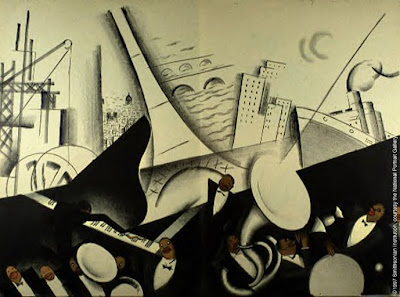
Josephine Baker became the toast of Paris when she danced the Charelston with her jazz review, "Le Tumulte Noir." Parisians, and American expats loved the young American and her style of dance.
The Art Deco poster is representative of the graphics of the era. It depicts the night life and cosmpolitan atmosphere of Paris in the 1920s. Art Deco took its name from the 1925 Exposition of Decorative Arts in Paris.
Friday, April 20, 2007
Some Of The Lost Generation
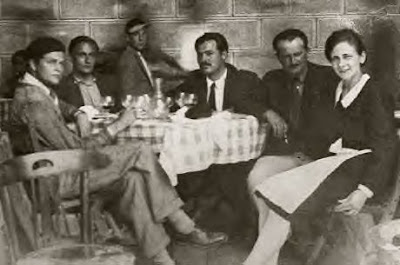
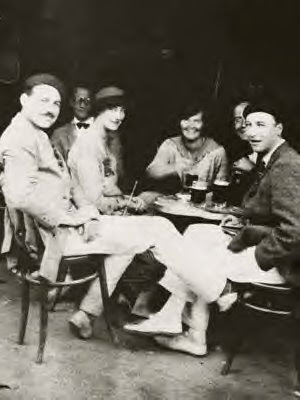
The Lost Generation: Hemingway and the circle of ex-pat friends he later incorporated in The Sun Also Rises. Top photo includes, Harold Loeb, the model for Robert Cohn in The Sun Also Rises, on the left, and Hemingway in the center.
In the bottom photo: Hemingway on the left, Harold Loeb, Lady Duff Twysden, Hadley, Don Stewart and Pat Guthrie.
Writing the book, Hemingway thought of himself as the Jake Barnes character, Lady Duff Twysden was Brett, Pat Guthrie was Mike Cambell, and as mentioned, Harold Loeb was Robert Cohn.
Sunday, April 08, 2007
Hemingway At Shakespeare And Company



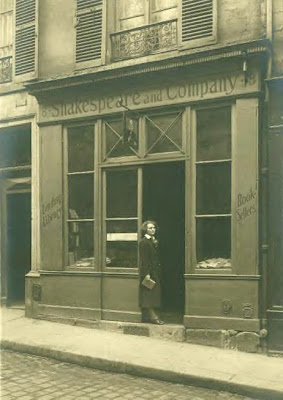
The top photo shows Sylvia Beach with her long time lover and business partner, Adrienne Monnier inside Shakespeare and Company bookstore at 12 rue de l'Odeon.
A photo of Sylvia Beach standing outside of her bookstore with Hemingway.
She was one of Hemingway's staunchest friends and supporters. She lent him books, money, and encouragement.

Ernest inside Shakespeare And Company in 1921.
Sunday, March 25, 2007
Picasso And Gertrude Stein



Pablo Picasso was one of Gertrude Stein's favorite artists and social contacts in Paris.
Gertrude Stein is shown sitting in front of a portrait of her painted by Picasso. The photo was taken by Man Ray in 1922. More on Miss Stein and Hemingway can be found in an earler post
Sunday, March 04, 2007
Jules Pascin






Jules Pascin was a good friend of Hemingway. He was a working artist, Bulgarian by birth, and a regular of the Left Bank cafe circuit. Like Hemingway, he usually only went out to drink after getting in a good day's work. They frequently met at the Dome Cafe, a cafe Hemingway liked because many of the regulars were artists that had worked at their craft that day and were not just out to be "seen." In "A Moveable Feast," Hemingway devotes a short chapter to his friend, called: With Pascin at the Dome. Pascin who suffered from alcoholism and depression hanged himself when he was 45.
The first painting is "Woman at Her Toilet."
The second painting is of Pasin's mistress, Lucy Krohg.
The next painting is titled "Nude Sleeping."
After the photo of Pascin is a self-portrait by him done in 1921. Then, a portrait of him painted in 1906 by Albert Weisgerber.
Thursday, February 22, 2007
Robert McAlmon



Robert McAlmon (on the right with Hemingway, first photo) was one of the wealthier American expats in Paris. He married into his wealth. He was a poet and writer who wanted to start a publishing house for new writers. He started Contact Editions and used Shakespeare & Co. as his office.
He met Hemingway and the two became friends even though the relationship had its stormy times.
They travelled to Spain with Bill Bird for Ernest's first exposure to bullfighting - in the photo above they are in the Spanish town of Ronda in the bullring there.
The third photo shows Hemingway's first published work - published by McAlmon in 1923.
The short stories were: My Old Man, Out of Season, and Up in Michigan.
The ten poems were:
Mitraigliatrice
Oklahoma
Oily Weather
Roosevelt
Captives
Champs d'Honneur
Riparto d'Assalto
Montparnasse
Along With Youth
Chapter Heading
Subscribe to:
Comments (Atom)














